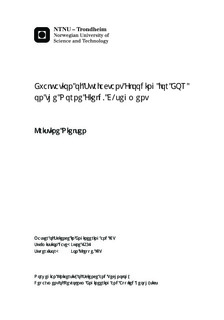Evaluation of Surfactant Flooding for EOR on the Norne Field, C-segment
Master thesis
Permanent lenke
http://hdl.handle.net/11250/239858Utgivelsesdato
2012Metadata
Vis full innførselSamlinger
Sammendrag
The world’s energy demand is constantly increasing. It offers a problem when hydrocarbons both are the most energy efficient source known in combination with being a limited resource. This motivates to increase the recovery from existing oil fields by means of EOR methods. Surfactant flooding is such a method for enhancing the oil production from an oil field. The Norne field is located in the North Sea. It is divided into four segments where the C-segment is the focus area of this report. The production of oil started in 1997 and the production is now declining. Water is being injected, however, to extract more oil tertiary recovery is necessary. Surfactants aim to enhance the oil recovery by lowering the interfacial tension between oil and water and hence lower the capillary pressure. This will mobilize the residual oil and make it possible to produce. Surfactant flooding can be an effective technique to boost the recovery, but there are several challenges to overcome. These challenges include loss of surfactants to the formations, facility and costs. The Norne C-segment being an offshore field represents an extra challenge. Eclipse 100 is used as simulation tool to model the surfactant flooding. Prior to implementing the surfactant model, history matching was performed. This was to calibrate the model in order to ensure a better prediction of the activity in the reservoir. After implementing the surfactant model, four different cases was evaluated to find the optimum injection strategy. The cases include the injection into different formations, the use of different wells, and alteration of concentration and injection period. An economical evaluation was performed based on the results. The results from the simulations were somewhat surprising and unexpected. Despite being a suitable candidate through screening, surfactant flooding is not a feasible method to use at the Norne C-segment.
